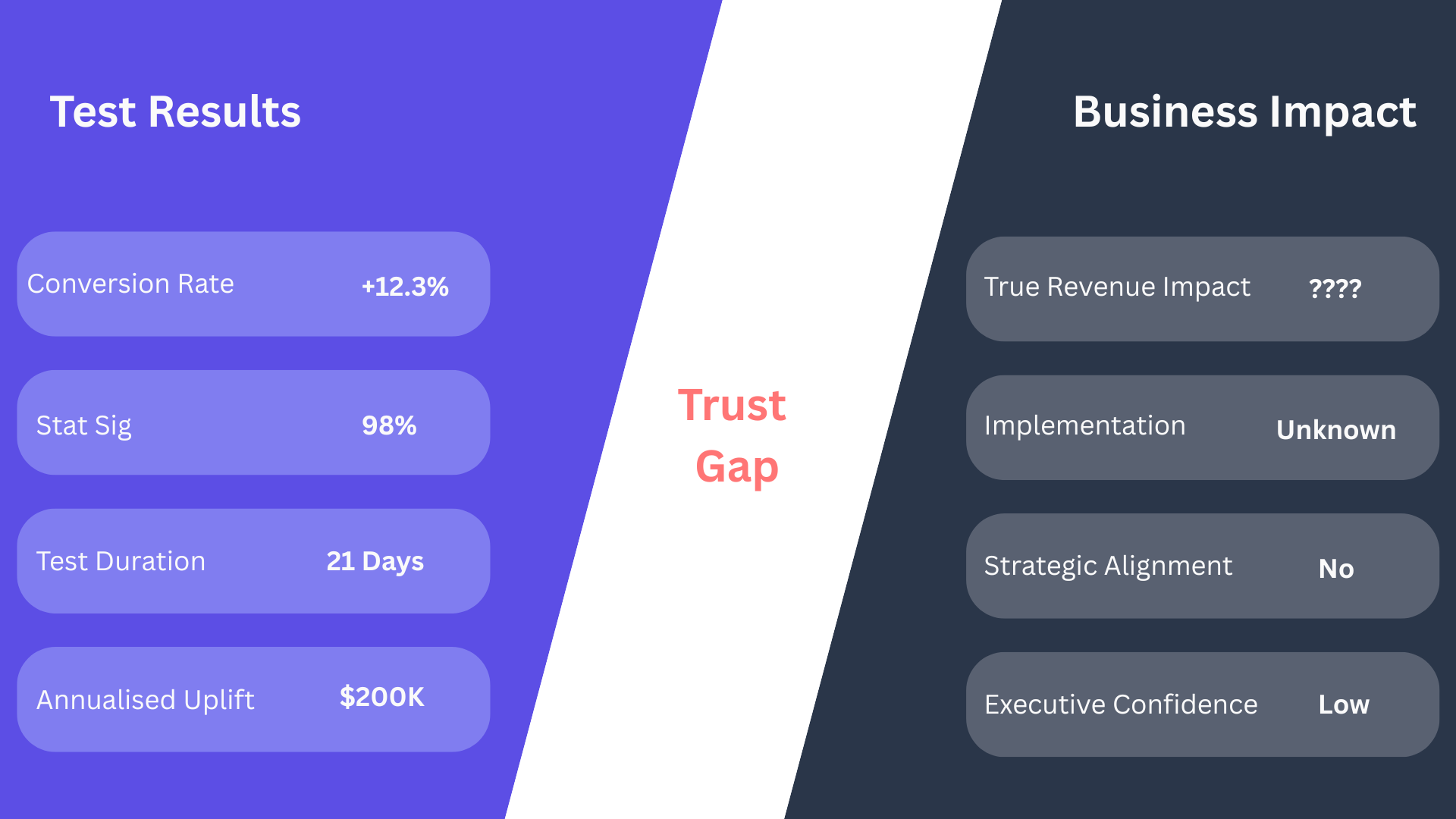Learning Center • 1-15 Minutes • Foundation Level
Understanding The Trust Gap in Experimentation
The critical disconnect between promising experiment results and actual business outcomes that undermines organizational confidence in experimentation programs.
What is the Trust Gap?
What is the Trust Gap?

Key Insight
The Trust Gap isn't just about failed implementations—it's about the erosion of confidence that prevents experimentation from becoming a strategic capability within organizations.
Symptoms & Indicators
Symptoms & Indicators
Implementation Failures
Ensures consistent methodology, statistical rigor, and reliable results across all experiments.
Executive Skepticism
Leadership questions the reliability of experiment results and hesitates to make strategic decisions based on test data.
Knowledge Silos
Insights from experiments remain trapped within teams, leading to duplicated efforts and lost learnings.
Vanity Metrics Focus
Teams celebrate test velocity and win rates while struggling to demonstrate actual business impact.
Warning Sign
"Experimentation governance is not about adding bureaucracy—it's about creating the structure that enables experimentation to reach its full strategic potential."
Root Causes
Root Causes of the Trust Gap
The Trust Gap emerges from systemic issues in how organizations approach experimentation, not from individual failures or lack of effort.
1. The Frankenstack Problem
Organizations cobble together disconnected tools—Airtable for tracking, Jira for implementation, Notion for documentation, Google Sheets for reporting. This fragmentation creates:
- No single source of truth for experimentation data
- Inconsistent methodology across teams
- Lost insights between tool handoffs
- Inability to track implementation outcomes
2. Methodology Inconsistencies
Without proper governance, teams develop their own approaches to experimentation:
- Variable statistical standards across teams
- Inconsistent test duration and sample size decisions
- Different definitions of “success”
- No quality control on experiment design
3. Strategic Misalignment
Experimentation programs often operate in isolation from strategic business objectives:
- Tests focus on tactical metrics rather than strategic outcomes
- No clear connection between experiments and OKRs
- Practitioners speak a different language than executives
- Limited visibility into how tests support business goals
4. Implementation Accountability Gap
The handoff from experiment to implementation often lacks proper governance:
- No tracking of whether winning variants were actually implemented
- Changes made during implementation that invalidate test results
- No validation that implemented changes delivered expected value
- Lack of feedback loop to improve future experiments
Business Impact
The Business Impact of the Trust Gap
42% Average implementation failure rate for "successful" experiments
1.2M% Average annual waste from failed implementations
68% Experiments disconnected from strategic objectives
3.2% Duplicated experiments due to knowledge silos
"We were running over 200 experiments a year, but when we looked closer, we realized only about 15% of our product decisions were actually being guided by reliable experimentation data. The rest was essentially informed guesswork wearing a lab coat."
Hidden Costs of the Trust Gap
-
Resource Waste
Teams spend months on experiments that never influence decisions or duplicate previous work. -
Opportunity Cost
Conservative decision-making due to lack of trust in experimental data slows innovation. -
Team Morale
Practitioners become demoralized when their work doesn't influence business decisions. -
Competitive Disadvantage
While competitors make confident, data-driven decisions, organizations with trust gaps fall behind.
Diagnosing Your Gap
Diagnosing Your Trust Gap
Understanding the severity of your organization’s Trust Gap is the first step toward addressing it. Use these diagnostic questions to assess your current state.
Quick Trust Gap Assessment
1. What percentage of your successful experiments are fully implemented as tested?
Red flag: Less than 60% | Warning: 60-80% | Healthy: Above 80%
2. Can you track the business impact of experiments 3-6 months after implementation?
Red flag: No tracking | Warning: Partial tracking | Healthy: Comprehensive tracking
3. How often do teams unknowingly duplicate previous experiments?
Red flag: Frequently | Warning: Occasionally | Healthy: Rarely or never
4. Do executives regularly reference experiment results in strategic decisions?
Red flag: Never | Warning: Sometimes | Healthy: Consistently
5. How many different tools do you use to manage your experimentation program?
Red flag: 4+ tools | Warning: 2-3 tools | Healthy: Unified platform
Get Your Complete Trust Gap Assessment
Our comprehensive Experimentation Confidence Quotient (ECQ) assessment provides a detailed analysis of your Trust Gap across five critical dimensions.
Closing the Gap
Closing the Trust Gap
Addressing the Trust Gap requires more than better tools or processes—it demands a fundamental shift in how organizations approach experimentation governance.
The Learning Loop Framework
Closing the Trust Gap requires implementing a complete Learning Loop that connects experimentation to strategic decision-making:
1
Strategic Direction
2
Governance & Structure
3
Knowledge Creation
4
Implementation & Action
5
Organizational Learning
Key Elements of Trust Gap Resolution
Governance Framework
Establish clear standards for experiment quality, methodology consistency, and decision protocols that ensure reliable results.
Strategic Alignment
Connect every experiment directly to business objectives, ensuring tests contribute to meaningful organizational outcomes.
Executive Visibility
Provide leadership with clear dashboards showing how experiments drive strategic outcomes, building confidence in the program.
Knowledge Preservation
Build institutional memory that captures and surfaces insights, preventing duplicate work and enabling compound learning.
Success Story "Experimentation governance is not about adding bureaucracy—it's about creating the structure that enables experimentation to reach its full strategic potential."
Additional Resources
Additional Resources
The Learning Loop Framework
Discover the complete framework for creating a continuous cycle of strategic experimentation and organizational learning